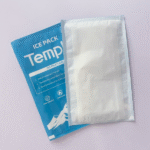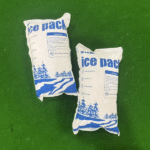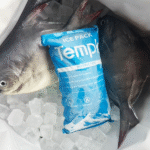Versand von Trockeneisbeuteln in 2025: So gewährleisten Sie eine sichere und effiziente Kühlkettenlogistik
Der Versand temperaturempfindlicher Güter erfordert eine sorgfältige Planung, insbesondere wenn Trockeneis verwendet wird, um Temperaturen unter Null zu halten. In diesem Leitfaden, Wir werden untersuchen, wie Trockeneisbeutel funktionieren, ihre Anwendungen in verschiedenen Branchen, Sicherheitsvorkehrungen, und wie die 2025 Die Kühlkettenlandschaft entwickelt sich weiter, um den modernen Versandanforderungen gerecht zu werden.
-
Wie funktionieren Trockeneisbeutel?, und warum sie für den Versand von entscheidender Bedeutung sind?
-
Was sind die Hauptanwendungen von Trockeneisbeuteln in verschiedenen Branchen??
-
Welche Sicherheitsvorkehrungen sollten beim Umgang mit Trockeneis beachtet werden??
-
Wie ist Lieferung von Trockeneis sich weiterentwickeln 2025?
Wie funktionieren trockene Eisbeutel?, und warum sie für den Versand unverzichtbar sind?
Trockeneisbeutel sind eine Form von verfestigtem Kohlendioxid (Co₂) das bei -78,5 °C direkt vom Feststoff in den gasförmigen Zustand sublimiert (-109.3° F), Daher sind sie für die Gefrierhaltung von Waren während des Transports unerlässlich. Im Gegensatz zu normalem Eis, welches schmilzt und feuchtigkeitsbedingte Schäden verursachen kann, Trockeneis lässt keinen Rückstand, Sicherstellung, dass Produkte wie Impfstoffe, Essen, und biologische Proben bleiben während des Transports trocken und kalt.
Warum Trockeneis effizienter ist als normales Eis
-
Feuchtigkeitsfrei: Trockeneis verhindert Feuchtigkeitsschäden, indem es zu Gas sublimiert, anstatt zu Wasser zu schmelzen.
-
Längere Dauer: Es kann Temperaturen unter Null viel länger aufrechterhalten als normales Eis.
-
Hervorragende Kältespeicherung: Trockeneis hält eine extrem niedrige Temperatur aufrecht, Dies ist für Produkte wie Impfstoffe und Tiefkühlkost von entscheidender Bedeutung.
Hauptanwendungen von Trockeneisbeuteln in verschiedenen Branchen
Pharmazeutische und medizinische Sendungen
In der Pharmaindustrie, Trockeneis ist für den Versand temperaturempfindlicher Güter wie Impfstoffe und Biologika unverzichtbar. Viele Impfstoffe, wie zum Beispiel diejenigen, die für COVID-19 verwendet werden, erfordern während des Transports Minustemperaturen. Trockeneis stellt sicher, dass diese Produkte im erforderlichen Temperaturbereich bleiben.
Lebensmittelindustrie
Auch in der Lebensmittelindustrie ist Trockeneis unverzichtbar. Es wird für den Versand verderblicher Waren verwendet, einschließlich Tiefkühlkost, Meeresfrüchte, und Eis. Die Kältespeicherung von Trockeneis trägt dazu bei, die Frische zu bewahren und den Verderb beim Transport über große Entfernungen zu verhindern.
Biotechnologie und wissenschaftliche Schifffahrt
Biotech-Unternehmen und Forschungslabore verlassen sich beim Transport empfindlicher biologischer Proben und Chemikalien auf Trockeneis. Trockeneis trägt dazu bei, die Integrität wissenschaftlicher Materialien zu wahren, indem es während des Transports eine stabile und zuverlässige Kühllösung bietet.
Sicherheitsaspekte beim Umgang mit Trockeneis
Trockeneis, während es als Kühlmittel äußerst wirksam ist, kann bei unsachgemäßer Handhabung Risiken bergen. Hier finden Sie die wesentlichen Sicherheitsrichtlinien:
-
Verwenden Sie Schutzausrüstung: Tragen Sie stets isolierte Handschuhe, um Erfrierungen vorzubeugen.
-
Stellen Sie eine angemessene Belüftung sicher: Denn Trockeneis sublimiert zu CO₂, Eine ordnungsgemäße Belüftung ist entscheidend, um Erstickungsgefahr in geschlossenen Räumen zu vermeiden.
-
Richtige Lagerung und Verpackung: Lagern Sie Trockeneis in belüfteten Behältern, um einen Druckaufbau zu verhindern, und vermeiden Sie die Verwendung luftdichter Verpackungen.
Beispiel für reale Welt: Ein Logistikunternehmen hatte Probleme bei der Verwendung luftdichter Behälter für Trockeneis, was während des Transports zu einem Platzen führte. Die Verwendung einer belüfteten Verpackung hätte dieses Problem verhindern können.
Trends bei der Lieferung von Trockeneis für 2025
Wachsende Nachfrage nach umweltfreundlichen Lösungen
Nachhaltigkeit ist zu einem zentralen Trend in der Logistik geworden, Viele Unternehmen suchen nach umweltfreundlichen Alternativen zu herkömmlichem Trockeneis. Dazu gehören biologisch abbaubare Trockeneisbeutel und Methoden zur Kohlenstoffabscheidung, die den ökologischen Fußabdruck des Versands verringern.
Fortschrittliche Tracking- und Überwachungssysteme
2025 verzeichnet einen zunehmenden Einsatz von Echtzeit-Tracking-Systemen für Trockeneissendungen. Mit diesen Systemen können Unternehmen den Zustand ihrer Produkte während des Transports überwachen, Sicherstellen, dass sie innerhalb des erforderlichen Temperaturbereichs bleiben.
Innovationen bei Trockeneis-Versandbehältern
Neue Entwicklungen bei isolierten und effizienten Trockeneisbehältern tragen dazu bei, die Menge an Trockeneis zu reduzieren, die für Sendungen benötigt wird, Dadurch werden sowohl die Kosten als auch die Umweltbelastung gesenkt.
Wie viel Trockeneis brauchen Sie wirklich?
Die benötigte Menge an Trockeneis hängt von mehreren Faktoren ab, wie zum Beispiel das Gewicht des Produkts, Versanddauer, und Umweltbedingungen. Eine allgemeine Richtlinie ist die Verwendung 5 Zu 10 Pfund Trockeneis pro 24-Stunden-Transitzeitraum. Für genauere Berechnungen, Oft wird eine Formel verwendet:
Erforderliches Trockeneis (lb) = Produktgewicht (lb) × 0.6 × Transittage × Temperaturfaktor.
Zum Beispiel, Der Versand eines 20-Pfund-Mahlzeitenpakets für zwei Tage bei -20 °C würde etwa kosten 31 Pfund Trockeneis.
Verpackung und Versand mit Trockeneis
Durch die richtige Verpackung wird sichergestellt, dass Trockeneis während des gesamten Transports effizient funktioniert. Hier erfahren Sie, wie es geht:
-
Wählen Sie den richtigen Behälter: Verwenden Sie isolierte Boxen oder Kühlboxen, um die niedrigen Temperaturen aufrechtzuerhalten.
-
Bereiten Sie das Trockeneis vor: Stellen Sie sicher, dass es in einen belüfteten Behälter gegeben wird, um die Sublimation zu ermöglichen.
-
Verpacken Sie das Produkt: Umgeben Sie Ihr Produkt mit Trockeneis, um eine gleichmäßige Kühlung zu gewährleisten.
-
Etikett und Siegel: Sichern Sie den Behälter und kennzeichnen Sie ihn deutlich mit den entsprechenden Gefahrstoffkennzeichnungen.
Versandvorschriften
Trockeneislieferungen werden von verschiedenen Organisationen reguliert, einschließlich der UNS. Verkehrsministerium (PUNKT) und die Federal Aviation Administration (FAA) für den Luftverkehr. Befolgen Sie unbedingt alle Verpackungsvorschriften, Beschriftung, und Dokumentationsanforderungen, um die Einhaltung sicherzustellen.
Die Kosten für die Lieferung von Trockeneis
Für den Versand von Trockeneis fallen verschiedene Kosten an, inklusive Liefergebühren und dem Preis pro Pfund. Hier finden Sie eine Zusammenfassung typischer Lieferdienste:
| Lieferantentyp | Preisklasse | Mindestbestellmenge & Gebühren | Am besten für |
|---|---|---|---|
| Abholung vor Ort | $1.50–3,15 $ | Nicht das Geringste | Kleine Mengen für den persönlichen Gebrauch |
| Online -Händler | $0.60– 1,50 $ | Minimum 10 lb | E-Commerce-Versand |
| Notdienste | Variiert | Kein festes Minimum | Krankenhäuser, Rechenzentren |
| Industrielle Zulieferer | $2.25 pro lb | Minimum 5 lbs | Labore, Herstellung |
Kostensparende Strategien
-
Bestellen Sie die richtige Menge: Vermeiden Sie Überbestellungen, um Abfall zu minimieren.
-
Vergleichen Sie Abholung vs. Lieferung: Für kleinere Mengen, Eine Abholung vor Ort kann günstiger sein.
-
Großbestellungen: Sammeln Sie Bestellungen mit anderen Unternehmen, um ermäßigte Preise zu erhalten.
Häufige Fragen
Q1: Was ist der Unterschied zwischen Trockeneis und normalem Eis für den Versand??
Trockeneis ist viel kälter und sublimiert zu Gas, während normales Eis zu Wasser schmilzt, die Produkte beschädigen können.
Q2: Kann trockene Eis für den internationalen Versand verwendet werden?
Ja, Für internationale Trockeneissendungen gelten jedoch spezifische Vorschriften zu Menge und Verpackung.
Schlussfolgerung und umsetzbare Tipps
Für den sicheren Transport temperaturempfindlicher Güter sind Trockeneisbeutel unerlässlich. Durch die Auswahl der richtigen Form, Berechnung der erforderlichen Menge, und Einhaltung der Sicherheitsvorschriften, Unternehmen können für Sicherheit sorgen, kostengünstig, und effiziente Kühlkettenlogistik.
Nächste Schritte:
-
Bewerten Sie Ihre Bedürfnisse: Berechnen Sie die benötigte Trockeneismenge für Ihre Sendung.
-
Wählen Sie das richtige Paket: Wählen Sie das beste Trockeneisformat für Ihr Produkt.
-
Wählen Sie einen Lieferanten: Vergleichen Sie Preise und Leistungen verschiedener Anbieter.
-
Priorisieren Sie die Sicherheit: Befolgen Sie beim Umgang mit Trockeneis alle Sicherheitsrichtlinien.
Über Tempk
Tempk ist auf maßgeschneiderte Kühlkettenlösungen spezialisiert, einschließlich Trockeneis, Gelpackungen, und isolierte Versender. Wir beraten Sie kompetent, Regulierungsschulung, und Lieferstrategien für Branchen wie die Pharmaindustrie, Essen, und Biotech. Kontaktieren Sie uns noch heute, um Ihre Kühlkettenlogistik zu optimieren.






















